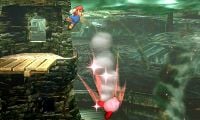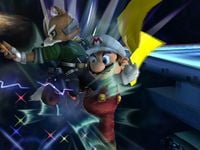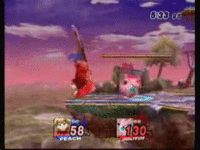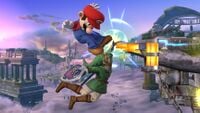Edgeguarding
- "Edgeguard" redirects here. For the tournament, see Tournament:Edgeguard.

Edgeguarding is the attempt to prevent an offstage recovering opponent from reaching the stage, thus causing them to be KO'd. Players can achieve this in many ways, and the struggle between an edgeguarder and their recovering opponent often leads to many strategies and mindgames. The anti-strategy to this is the guard break.
Execution[edit]
There are two main methods of edgeguarding. One is to run or jump off the stage and attack; this is often done by characters with great jumping ability, which includes multiple jumps and good recoveries such as the Robo Burner. The other is to stay on the stage and attack the opponent when they recover should they fail to sweetspot the ledge. This is mostly done with down smashes and tilts, and even some projectiles.
Any character can edgeguard, although some are better at it than others. A character's ability to edgeguard offstage is determined by two factors: the length and safety of their recovery, and the utility of their aerial attacks. The most prominent example is Meta Knight, as his recovery is effectively immune to edgeguarding, and because his aerials are quick and send opponents on favorable trajectories. However, some characters are strong edgeguarders despite having subpar recoveries; Ganondorf is the best example. His recovery is slow and short, but all of his aerials are deadly offstage.
Certain characters are worse at defending themselves from edgeguards. These are generally characters with predictable recoveries (like Captain Falcon or Marth), slow and/or easily-disruptable recoveries (like Ness or Lucas), characters reliant on tether recoveries (like Olimar in Brawl or Ivysaur), or characters without a damaging recovery move (like Lucario in Brawl or Olimar in SSB4 and Ultimate).
In general, the recoveries of the cast have improved across the games. In Smash 64, aside from Pikachu and, to a smaller extent, Mario, all characters have predictable recoveries, leaving them vulnerable to edgeguards, which is further compounded by the game's high hitstun.
Melee recoveries, while still rather predictable, are benefited by ledge teching. Jigglypuff and Samus are well-known for their recovery ability, with the former having arguably the strongest edgeguarding ability in the game. Melee introduces meteor cancelling, which makes meteor smashes much less potent at securing offstage KO's. However, the increased falling speeds and gravity make semi-spikes more effective. Certain attacks, known as spikes, have downwards knockback that are not recognized as meteor smashes, and characters who possess these moves often utilize them in their edgeguarding, most notably Marth, Captain Falcon, and Falco.
In Brawl, recoveries are overall longer, and the larger ledge sweetspots, as well as the auto-sweetspot mechanic, make edgeguarding less effective. The meteor smash recognition window has been expanded, removing the spikes of the previous game. Meta Knight is infamous for his immunity to being edgeguarded, due to his plethora of recovery options, with his recovery being the best not only in Brawl, but arguably the entire series, and this grants him his powerful offstage game. Brawl's floatier physics, low hitstun, meteor cancelling, air dodges, and the aforementioned changes to ledge sweetspots arguably make edgeguarding in this game the least effective out of all five iterations, along with the ability to buffer wall techs being removed. In these three games, edgehogging is a commonly used tactic to stop opponents who aim their recoveries to the ledge.
In Smash 4, recoveries on their own were generally buffed, and ledges were reworked to remove edgehogging, reducing the effectiveness of onstage edgeguarding, and simultaneously making planking impossible by altering edge regrabbing, so that grabbing an edge again will not grant a character any intangibility, until the character lands back on stage or takes hitstun. However, meteor cancelling has been removed, making meteor smashes as deadly as they were back in Smash 64. The new ledge stealing mechanic can set up recovering opponents for an attack, most commonly a back aerial. The longer recoveries enforce and encourage more aggressive offstage play, as offstage edgeguarding carries much less risk than before, since an edgeguarder can no longer be edgehogged if their attempt is unsuccessful. Also, the improvements to recoveries are not consistent across the cast. Marth's recovery is largely unchanged from before; Fox's recovery is twice as long as in Brawl, as Fox Illusion and Fire Fox can now be used in tandem, Ganondorf's recovery is even worse due to his lowered air speed and the removal of grab armor, and Charizard suffers severely with the loss of gliding despite the addition of Flare Blitz. Most notably, Smash 4 introduces Little Mac, whose recovery is undoubtedly the worst in the entire series. Lastly, in Smash 4, teching cannot be performed during hitlag, causing certain stage spikes to be untechable, and the new ledge mechanics make stage spikes more common than in past games. All these changes have contributed to more offstage battles in competitive play, as edgeguarding is much safer while still rewarding if successful. As in Brawl, Meta Knight is noteworthy for his edgeguarding ability, along with characters who possess useful meteor smashes, particularly Captain Falcon and Ganondorf.
In Ultimate, ledge sweetspots were overall toned down, making it more difficult to recover safely and easier to edgeguard as a result. Additionally, the changes to air dodge mechanics make it much harder to avoid edgeguarding than the previous games. However, techs have been altered considerably: there is a noticeably larger tech window than the previous games, but techs can no longer be performed if a strong enough attack connects. This makes stage spikes more or less effective depending on the opponent's current damage.
Edgeguarding strategies[edit]
Onstage guarding[edit]
The simplest and safest way to edgeguard is to stand at the edge and throw attacks — often a powerful forward smash, down smash, or down tilt that can hit even an edge sweet spotting enemy. While this method of edgeguarding requires the least setup, it is often thwarted by sweetspotting or ledge teching.
Using projectiles[edit]
In a similar strategy to sitting on stage, a character with projectiles (especially projectiles affected by gravity, like Peach's turnips or Mario's fireballs) can stand by the edge and try to interrupt a faraway, recovering opponent. This strategy is very safe, in that players are very unlikely to be hit while edgeguarding in this fashion, and it can be combined with both edgehogging and attacking from onstage.
Offstage guarding[edit]
A risky, but deadly, way of edgeguarding is to jump offstage and interrupt the opponent in midair. The recovering enemy has few options by which they can defend themself, such as using aerial attacks, air dodging, or directing themself away from the edgeguarder, all of which can cause their recovery to fail even if they thwart or avoid the enemy's attack. When using this style of edgeguarding, most characters put their own life in jeopardy, being so far offstage. If, however, the edgeguarder is able to land a powerful aerial attack (like Captain Falcon's Knee Smash) far offstage, their enemy will almost certainly get KOed. Even if unsuccessful, the edgeguarder can often edgehog the recovering opponent anyways, pre-SSB4.
With most characters, it is best to avoid using the second jump before hitting the opponent. Many characters will not be able to make it back without it. Characters such as Jigglypuff, Kirby, and Meta Knight are very useful characters to use for this strategy, since their multiple jumps allow them to go far off stage, deliver an aerial attack, and return to the stage afterwards.
Edgehogging[edit]
A common way to edgeguard is to edgehog, or grab the ledge so that the opponent cannot. There are several ways to reach the ledge when standing onstage. The two most common ways are to face away from the ledge and either short hop or wavedash backwards. Many players, when wavedashing backwards, make the mistake of standing too close to the edge before wavedashing, thereby air dodging offstage and self-destructing. Note also that with some characters, it is possible to fastfall the wavedash off the stage and in effect grab the edge sooner.
Usually, an edgehogger rolls the moment the recovering enemy uses their third jump, gaining invincibility frames and defending themself against damaging up special moves. Edgehogging is effective against sweetspotting, but can be beaten by an enemy that comes fully onstage in their recovery.
When an enemy lands fully onstage, they are often caught in the lag of their third jump. Edge hopping is often the method to keep them off the stage. This causes one to return to the starting position of choosing which edge guarding technique to use, but the opponent has slightly more damage, leading to a constant edgeguard game.
Edgehogging is not possible in Super Smash Bros. 4 and Super Smash Bros. Ultimate because of the ledge trump mechanics.[1].
Ledge trumping[edit]
Starting in Super Smash Bros. 4 and onward, grabbing onto a ledge that has already been grabbed by another player will gently remove them from the ledge. While ledge trumping was intended to negate edgehogging, it can still be used as an effective edgeguard; an onstage player ledge trumps a recovering player by running offstage and fastfalling onto the ledge as soon as the recovering player grabs it. This causes the recovering player to automatically let go of the ledge and they cannot take any action for a moment, allowing for an easy combo, such as Sheik's back aerial. In addition, the removal of ledge regrab invincibility can be exploited by a ledge trump edgeguard.[2]
To avoid getting ledge trumped, one can simply buffer an attack, a jump, or a roll from the ledge the moment it is grabbed. A regular getup and dropping from the ledge cannot be buffered, making it much easier to trump someone attempting these ledge options, and waiting too long to buffer the previous options will still result in getting trumped. These can all be mixed up for mindgames.
Deterrence[edit]
A somewhat underutilized ability, deterrence, is basically fake offstage guarding. The player would make to jump towards the opponent trying to recover, but instead return to the stage without ever engaging the enemy. If done convincingly, the opponent will attempt to evade the nonexistent attack and hopefully miss the ledge or dodge right into a different attack.
While this strategy works against newer players, it usually requires a twist against more advanced combatants. In this case, doubles play is usually necessary.
For example, one possible strategy involves Marth attempting a spike on an oncoming enemy from an above platform, while having Roy charge a Flare Blade below. From here, one of four things happen:
- Marth connects the spike and KO's the enemy
- Marth spikes the enemy into Roy's Flare Blade
- In attempting to evade Marth's spike, the enemy lands in the hitbox of Roy's Flare Blade
- In attempting to evade both attacks, the enemy completely misses the edge.
Notable edgeguarders[edit]
Smash 64[edit]
- Captain Falcon: His down air is a quick and powerful meteor smash with a long duration. His up air is a powerful semi-spike during the late hitboxes. Neutral and back air are both fast, decently strong, and the former has a lingering hitbox. Down tilt is a quick semi-spike.
- Kirby: Like Pikachu, his back air is fast, disjointed, and powerful. Neutral air is also fast and powerful with a lingering hitbox. All of down air's hits are powerful, overlapping meteor smashes. Down tilt is a strong semi-spike with decent range.
- Pikachu: With a long, quick, and safe recovery, Pikachu can go far offstage, where its fast, disjointed, and powerful back air is deadly. Like the above two characters, it has a quick and powerful neutral air with a lasting hitbox. Thunder Jolt climbs down surfaces and can be useful for gimping opponents recovering low.
Melee[edit]
- Falco: Down air has quick startup and a spike hitbox throughout the entire move. Neutral and back air are fast, strong, and have a long duration. Blaster is effective for gimping recoveries. His down smash is a fast and strong semi-spike with a good hitbox.
- Fox: His Reflector has no startup and semi-spikes opponents. Like Falco, back air is also effective, though risky due to Fox's fall speed.
- Jigglypuff: It can perform the Wall of Pain, which involves chaining its back air into itself and carrying the opponent offstage. Neutral and forward air are each fast moves with lingering hitboxes.
- Marth: His down air has low startup, a large hitbox, and spikes with high knockback. Down tilt is a very disjointed semi-spike. His forward aerial is effective as well.
- Pikachu: The middle hitbox of its up air is a weak semi-spike that can be chained into itself. Back air is fast and decently strong. Thunder Jolt is still a decent gimping option.
Brawl[edit]
- Falco: His down air has quick startup and meteor smashes powerfully in the first few frames. Back air is still a fast and long-lasting move, and down smash and Blaster retain their effectiveness as well.
- King Dedede: His back air is quick, disjointed, has a lingering hitbox, and is relatively strong. Waddle Dee Toss is very effective for gimping if the Gordo is pulled out.
- Marth: His forward and back air are quick, have long reach, and deal moderate knockback. His down air is a strong and fast meteor smash with a wide range.
- Meta Knight: With an incredible recovery and fast aerials, he can perform a pseudo-Wall of Pain with his forward and back airs. His down air is a quick and moderately strong semi-spike, and his neutral air also deals relatively high knockback with a long duration. Aerial Shuttle Loop is a powerful semi-spike as well. Down smash is another very quick and effective semi-spike.
- Peach: All of her aerial moves are excellent off the stage thanks to float, though only forward air is a strong KO move. Toad can be used to counter opposing recoveries. Her down special is also a projectile with solid gimping potential.
- Wolf: His back air is quick, ranged, and strong. His down air is a strong meteor smash, and Wolf Flash can be used to catch opponents off guard with both meteor smash and semi-spike hitboxes.
Smash 4[edit]
- Bayonetta: Her neutral and up air come out relatively fast, but have the added benefit of being extendable if the attack button is held for a time. Her down smash and down air can also cover nearly all horizontal recovery options as both are relatively strong meteor smashes. The latter also has a landing hitbox with decent knockback.
- Bowser: Back air is among the most powerful semi-spikes in the game, and is also very fast with good range. Forward smash can hit ledge if spaced correctly, and Fire Breath can be used to push opponents away from the ledge. Forward air has quick startup and deals strong horizontal knockback.
- Captain Falcon: His down air and up tilt have large hitboxes and are powerful meteor smashes. His Knee and back air are also still useful.
- Fox: His back air is decently fast and is a rather strong semi-spike if sweetspotted. Since forward air's first four hits have very high set knockback and send at the autolink angle, the opponent is sent down with high hitstun, enough to follow up into a footstool to successfully edgeguard the opponent if a fast fall is inputted alongside the forward air. Reflector is still capable of gimping due to its high hitstun.
- Ganondorf: The removal of meteor cancelling makes his down air and Wizard's Foot meteor smashes even deadlier than before. Up air still semi-spikes effectively. Forward, neutral, and back air also retain their usefulness.
- Greninja: Hydro Pump is effective at disrupting recoveries, as the water does not cause flinching. Forward air is powerful, fast, and disjointed. Water Shuriken and back air are capable of gimping recoveries.
- Ike: His back air is quick, long-ranged, and deals high knockback. Eruption has a deceptively large hitbox which can also hit opponents on ledge. Down air's sweetspot is a strong meteor smash with long vertical range. Forward air is very strong and has a massive hitbox.
- Little Mac: Despite his infamously weak offstage presence, Little Mac can still edgeguard with his down smash, which is very strong, fast, and can semi-spike, or with Jolt Haymaker, which stage spikes powerfully against opponents grabbing ledges. His forward and back air can also be ironically useful edgeguarding tools, as their speed and semi-spike angles allow them to surprise enemies who do not expect Mac to get in the air.
- Luigi: Can use his Luigi Cyclone to gimp an opponent, by fastfalling and mashing the special button to rise afterwards, hitting the opponent with only the looping hits. Since the move's looping hitboxes have high base knockback and extreme knockback scaling as well as sending at the autolink angle, opponents are meteor smashed with very high hitstun, which proves very effective against slow, low recovering opponents, recovery moves without a hitbox, or trade with characters with short-length recovery moves.
- Mario: F.L.U.D.D., Fireball, and Cape are very useful tools against recovering opponents, the latter being very quick and able to reverse most up special moves. Forward aerial is a powerful spike with a large hitbox. Down smash is a fast and powerful semi-spike.
- Marth/Lucina: Forward and back air are useful offstage due to their speed, range, and power. Dolphin Slash is also useful against opponents near the ledge, since it can stage spike very easily. Marth's tipped forward smash is also capable of hitting opponents on the ledge if spaced correctly, almost guaranteeing a KO if it does. Down air is also a powerful spike if sweetspotted.
- Ness: the tail of his PK Thunder is a great tool for preventing characters from returning to the ledge. PK Fire is another effective tool, as attempting to SDI it offstage is incredibly risky. Ness's forward, back, and neutral airs are all effective tools for edgeguarding because of their fast speed and high knockback. Down air is a highly capable meteor smash. Ness's down smash is one of the best tools for 2-framing recoveries in SSB4.
Ultimate[edit]
- Donkey Kong: Down air and forward air are both powerful meteors with high knockback. Hand Slap is good for catching linear recoveries and can also meteor smash.
- Pikachu: Pikachu is a floaty character, which enables it to spend a lot of time in the air. Most of its aerials last for a long time, which, paired with Thunder Jolt's ability to block certain recovery routes and Pikachu's own long recovery, allow it to safely apply major pressure to recovering opponents.
- Simon and Richter: Axe is notorious for its usage near the edge, being powerful, having the ability to change its trajectory, and literally going through the stage to stop recoveries. Cross and Holy Water can also gimp opponents to a lesser degree.
- Incineroar: Forward and back air are incredibly fast and possess high knockback. Down air is an incredibly strong meteor when sweetspotted, and even the weak hit sends at a decent horizontal angle. Its Smash attacks are also useful for applying pressure on ledge thanks to their power and range. Its special moves also have some edgeguarding use with Alolan Whip capable of gimping opponents, with the late sourspot or a very early kill with the perfect timed hit depending on where they are facing. Cross Chop can be used as a sacrificial edge-guard due to its meteor smash killing at virtually any percentage off-stage, much like Chrom's Soaring Slash.
- Steve: The blocks Steve can place with Mine / Craft / Create Block allow for an unorthodox form of edgeguarding; while not damaging in themselves, the blocks can be used to wall off edges and have no edges of their own that can be grabbed onto. Opponents that cannot go over the blocks or break through them will subsequently be unable to recover. Steve can also utilize these blocks to perform grounded moves such as down smash, which due to its strong semi-spike knockback is deadly offstage.
- Sephiroth: The very long range of his Masamune allows him to both edgeguard and ledge trap rather effectively. His forward aerial is a great poking tool which combos into itself effectively when he is in winged form. Back aerial is very strong when sweetspotted. Down aerial hits below the ledge, allowing him to meteor smash opponents onstage. His special moves all posses edgeguarding potential; Flare / Megaflare / Gigaflare work as great and respectable edge trapping tools, especially with the power of the latter two. Shadow flare can interrupt jumps and can easily finish off opponents close to the blast zone upon the five second detonation. Octaslash is very powerful and long ranged and can either be used as a sacrificial KO, or even safely such as when angling it upwards. Lastly, Scintilla is a very strong counter attack when it connects and the automatic particles can also gimp opponents.


